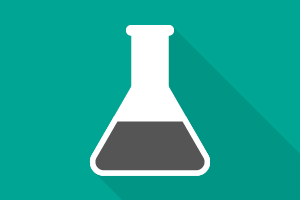Classroom Resources: Energy & Thermodynamics
Filter by:
26 – 42 of 42 Classroom Resources
-

Chemical Change, Exothermic & Endothermic, Redox Reaction, Reaction Rate | High School
Demonstration: Potassium Permanganate Demo Mark as Favorite (10 Favorites)
In this demo, students witness two chemicals that take some time to react. The KMnO4 and glycerin come into contact and appear not to react, but then a flame results. This is an example of an exothermic redox reaction.
-

Concentration, Beer's Law, Electromagnetic Spectrum | High School
Lesson Plan: Using Color to Identify an Unknown Mark as Favorite (20 Favorites)
In this lesson students will utilize spectrophotometry to identify the wavelength of maximum absorbance for a food dye. They will also generate a Beer's Law Standard Curve, and utilize their skills to identify the different dyes and their concentrations in an unknown mixture. The lesson culminates with an extension to utilizing a similar method in color matching paint.
-

Atomic Theory, Law of Conservation of Energy, Electrons, Electromagnetic Spectrum | High School
Activity: Simulation Activity: Exciting Electrons Mark as Favorite (94 Favorites)
In this simulation, students will explore what happens when electrons within a generic atom are excited from their ground state. This is a qualitative investigation, not meant to mimic any particular atom.
-

Review, Culminating Project, Mixtures, Separating Mixtures, Beer's Law, Concentration, Redox Reaction, Half Reactions, pH, Titrations, Buffers, Indicators, Ionic Bonding, Covalent Bonding, Alloys, Percent Composition, Le Châtelier's Principle, Enthalpy, Calorimetry, Conductivity | High School
Lesson Plan: AP Chemistry Experimental Evidence Review Mark as Favorite (52 Favorites)
In this lesson, students will evaluate data from 16 simulated lab experiments that were designed to mirror the Recommended Labs from the College Board. Corresponding lab experiments and demonstration options have also been included for teacher reference.
-

Emission Spectrum, Emission Spectrum, Electromagnetic Spectrum, Subatomic Particles, Electrons, Atoms, Atomic Theory, Model of the Atom | High School
Lesson Plan: Modeling Energy in Chemistry: Energy and the Electron Mark as Favorite (69 Favorites)
This activity is designed for students to build a scientific argument about the relationship between energy and spectral lines by exploring how light interacts with atoms. In the process, students will examine proposed models of the hydrogen atom and use collected data to analyze the proposed models. They will then select one of the models and write a scientific argument to support their choice. Students will then review additional data to support and/or refute their selection. Based on their analysis, students will revise their selected model and construct a new argument to support their revisions.
-

Catalysts, Order of Reaction , Activation Energy, Lewis Structures, Resonance, Molecular Geometry, Activation Energy, Energy Diagrams | High School
Lesson Plan: The Downside to Catalysts - An Exploration of CFC's on the Ozone Layer Mark as Favorite (37 Favorites)
In this lesson students will make observations of a colorful homogenous catalyst and intermediate in a reaction demonstration that will spark their interests. They will then work in teams to analyze graphs and data sets in order to make a real-world connection to AP topics in kinetics such as catalysts, intermediates and reaction mechanisms by exploring how CFCs work to break down the ozone layer. Students will also investigate and discuss this environmental issue.
-

Colligative Properties, Specific Heat, Freezing Point Depression, Solute & Solvent, Concentration, Heat, Temperature, Calorimetry, Error Analysis | High School
Lesson Plan: The Hot and Cold of it All Mark as Favorite (14 Favorites)
In this lesson students will analyze the effectiveness of different brands of antifreeze/coolants and their ability to protect an engine in cold climates. Students will conduct a lab investigation to examine the freezing point depression in samples that have been diluted with distilled water. Students will also determine the specific heat capacities of antifreeze/coolant products as compared to pure water and explain how it relates to thermal energy transfer in the internal combustion engine.
-

Electricity, Renewable Energy, Photosynthesis, Electron Transfer, Redox Reaction, Oxidation, Reduction | High School
Lesson Plan: Color Solar Power! Mark as Favorite (14 Favorites)
In this lesson students will make a dye-sensitized solar cell (also known as DSC or Gratzel cell) using extracts from blackberries, raspberries, blueberries, red cabbage, strawberries, beetroot, spinach and dried hibiscus petals. Students will measure the voltage and the current of various light sources using the created solar cells and then compare the effectiveness of each.
-

Conservation of Mass, Renewable Energy, Balancing Equations, Chemical Change, Functional Groups, Molecular Structure | High School
Lab: Soap or Fuel? Mark as Favorite (32 Favorites)
In this lab, students will transform vegetable oil into a soft soap and into biodiesel fuel. The two reactions emphasize that the products of a chemical reaction are under the control of the chemist. By noting the relationship of the reaction product to the reactants, students will gain a deeper understanding of the law of conservation of matter.
-

Atomic Theory, Law of Conservation of Energy, Electrons, Electromagnetic Spectrum | High School
Simulation: Exciting Electrons Mark as Favorite (67 Favorites)
In the March 2015 issue, students explore what happens when electrons within a generic atom are excited from their ground state. They will see that when an electron relaxes from an excited state to its ground state, energy is released in the form of electromagnetic radiation.
-

Combustion, Heat of Combustion, Stoichiometry, Balancing Equations, Dimensional Analysis, Interdisciplinary, Culminating Project | High School
Lesson Plan: Redesigning a Car for the Environment Mark as Favorite (26 Favorites)
Chemland’s city public transportation board has requested the class to help them determine the direction the city should move towards in reducing the carbon footprint. Students will be divided into groups and will come up with proposals of how to reduce the carbon footprint from carbon dioxide released from vehicles. The groups will represent different ways to reduce the carbon footprint via an alternative fuel source or a new technology. They will debate their findings to determine the direction that the city council should move towards to reduce the carbon footprint.
-

Pros Cons of Nuclear Power, Combustion, Acid Rain, Radiation, Renewable Energy, Radiation | High School
Activity: Town Meeting Mark as Favorite (37 Favorites)
In this activity, students will learn about acid rain, gas scrubbers, half-life, chain reactions, and other topics around electricity production through a debate on nuclear power.
-

Reduction, Oxidation, Redox Reaction, Catalysts, Activation Energy, Combustion | Elementary School, Middle School, High School
Video: Catalytic Converters Video Mark as Favorite (32 Favorites)
This video investigates the role of a catalytic converter and its corresponding chemical reactions within a vehicle. Students will learn about both oxidation and reduction reactions and how they, in combination with a catalyst, can impact the molecules released in a car’s exhaust.
-

Pros Cons of Nuclear Power, Radiation, Radiation, Renewable Energy, Interdisciplinary, History | High School
Activity: Nuclear Energy Debate Mark as Favorite (40 Favorites)
In this activity, students will watch a debate between experts on the merits and drawbacks of nuclear energy. They will use this debate, as well as additional research, to write a short position paper on whether or not to continue using nuclear energy that explains and defends their opinion, as well as the chemistry involved in nuclear energy production.
-

Pros Cons of Nuclear Power, Radiation, Radiation, Renewable Energy, Interdisciplinary, History | High School
Activity: Nuclear Energy Power Plants Mark as Favorite (29 Favorites)
In this activity, students will conduct research and write a persuasive essay in which they state an opinion about whether the number of nuclear plants should be increased or decreased.
-

Heat of Combustion, Heat, Exothermic & Endothermic, Combustion | Elementary School, Middle School, High School
Video: The Internal Combustion Engine Video Mark as Favorite (30 Favorites)
This video investigates both the mechanical and the chemical processes used in the internal combustion engine, as well as the history and evolution of the combustion engine.
-

Electricity, Anode, Cathode, Galvanic Cells, Heat, Renewable Energy | Elementary School, Middle School, High School
Video: Alternative Fuels Video Mark as Favorite (9 Favorites)
This video analyzes alternatives to petroleum based fossil fuels, such as biofuels and hydrogen fuel cells.